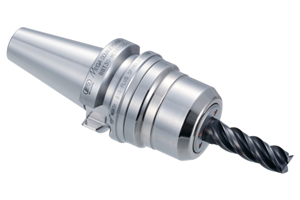IMC Group President Says Tool Value Comes from Productivity
Only cutting tool productivity can reduce other factors affecting part cost. Jacob Harpaz made this point at a recent Ingersoll Cuttings Tools event in Cleveland.
Share








Hwacheon Machinery America, Inc.
Featured Content
View More

The Ingersoll Cutting Tools event was held at the historic Cleveland Public Auditorium.
An improved cutting tool could deliver its improvement in any of three different ways. That tool could be cheaper, it could provide longer tool life or it could deliver greater productivity. IMC Group President and CEO Jacob Harpaz says go for the productivity. Now is the time for this.
That was his message at an Ingersoll Cutting Tools 125-year anniversary event last week. The event was held in Cleveland, birthplace of the cutting tool company. Now based in Rockford, Illinois, Ingersoll is today part of the IMC Group, which also includes cutting tool makers such as Iscar, Taegutec and Tungaloy. In presentations throughout the day-long event, Mr. Harpaz described various offerings in Ingersoll’s milling, turning and holemaking lines to an audience of about 850.
Business is good. After Ingersoll’s sales dropped in ’09, following the crash, the company had sales in ’10 that surpassed ’08. Then, after a flattening from ’11 to ’12, business has been increasing through the past two years. All of this is relevant to his message because many machining facilities have seen something like this same pattern of activity. Business is now strong enough in machining, particularly in North America, that any open time on a plant’s machine tools often can be filled. That means far and away the most lucrative return to get from a cutting tool is an improvement in productivity.
Shops do not necessarily see this, Mr. Harpaz says. Because a cutting tool is a consumable that is purchased again and again, its price is seen frequently, and therefore seems more significant than it might be. In most manufacturing processes, the impact of fixed costs and labor costs are actually much higher.
Specifically, for a representative machined part, he says the cost of machinery represents 26 percent of the cost of machining a part. Overhead represents 21 percent of the unit cost of machining. Labor and raw material account for 28 and 22 percent, respectively. Meanwhile, the cost of cutting tools accounts for just 3 percent.
That such a low share of the total cost comes from cutting tools has significant implications. Dropping the price of the tool by 20 percent, as big a change as this might seem, would deliver only a 0.6-percent unit cost reduction. The seemingly even greater change of increasing the life of the tool by a factor of 2 would save only 1.5 percent. But increasing productivity would increase the number of pieces the shop can produce in the same period of time, meaning the labor cost, overhead cost, and machinery cost per piece all go down. Increasing productivity by 20 percent thus produces a savings of 15 percent overall. Productivity increase delivers far and away the greatest savings, he says, because it is the only type of cutting tool improvement that can affect all the other cost factors.
The Ingersoll event showcased various new or improved cutting tool offerings aimed at this productivity increase. For example, the company’s TC430 whisker-reinforced ceramic insert for turning superalloys is more expensive than carbide tools used to turn these metals, but it is so much more productive that the cost increase is easily justified. (See video of the tool turning Inconel.) A couple of the company’s unusual offerings for productivity include:
- The Chip Surfer milling tool line, which consists of tools with changeable tips. The time savings here comes from quickly being able to replace a worn tool or switch to a different tool type just by changing the tip.
- Coolant-driven spindles able to deliver 40,000 rpm on a lower-speed machine for small tools requiring this rotational speed.
The most prominent product line at the event was the company’s “Gold Rush” line, which consists of tools benefiting from a post-coating treatment that enhances performance. Tools in this line can deliver long tool life compared to tools without the surface treatment. However, the more profitable use of the tooling is to let tool life remain steady, he says, and instead use the performance enhancement to increase speed and feed rate. Now is the time to go for productivity.
Related Content
Big Daishowa Chuck Eliminates Chatter in Milling Operations
The Mega 12DS chuck is designed for trochoidal milling with anti-vibration end mills.
Read MoreTungaloy Drills, Milling Inserts Provide Enhanced Stability
Tungaloy has expanded its DrillForceMeister and TecMill lines with new drill bodies and milling inserts.
Read MoreWidia Introduces Solid End Mill for Shoulder and Side Milling
The WCE solid end milling series features a five-flute geometry specifically designed for optimal performance when shoulder milling and side milling carbon, stainless steel and cast iron.
Read MoreHow to Mitigate Chatter to Boost Machining Rates
There are usually better solutions to chatter than just reducing the feed rate. Through vibration analysis, the chatter problem can be solved, enabling much higher metal removal rates, better quality and longer tool life.
Read MoreRead Next
5 Rules of Thumb for Buying CNC Machine Tools
Use these tips to carefully plan your machine tool purchases and to avoid regretting your decision later.
Read MoreRegistration Now Open for the Precision Machining Technology Show (PMTS) 2025
The precision machining industry’s premier event returns to Cleveland, OH, April 1-3.
Read MoreBuilding Out a Foundation for Student Machinists
Autodesk and Haas have teamed up to produce an introductory course for students that covers the basics of CAD, CAM and CNC while providing them with a portfolio part.
Read More

































.jpg;maxWidth=300;quality=90)




.jpg;maxWidth=300;quality=90)









